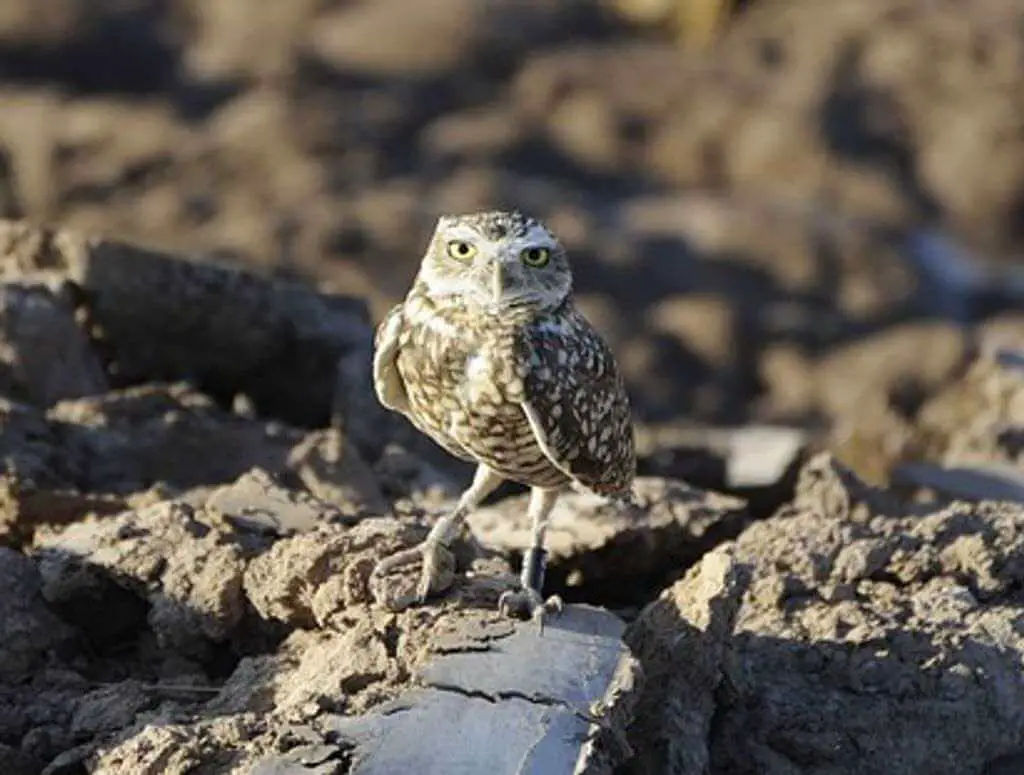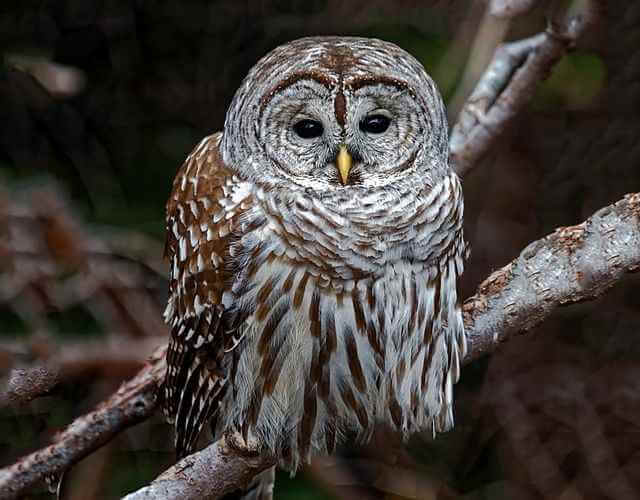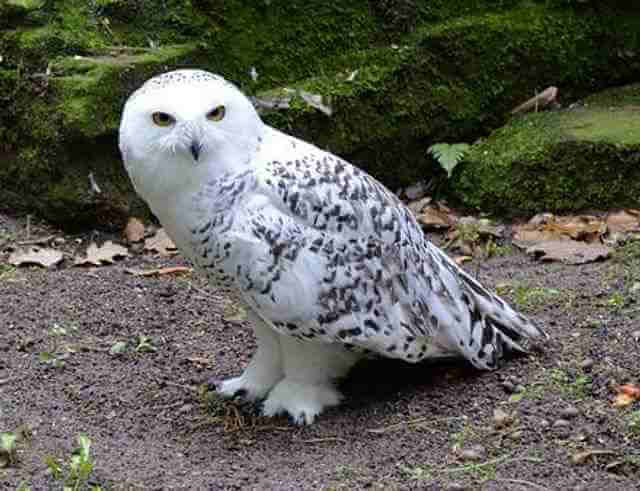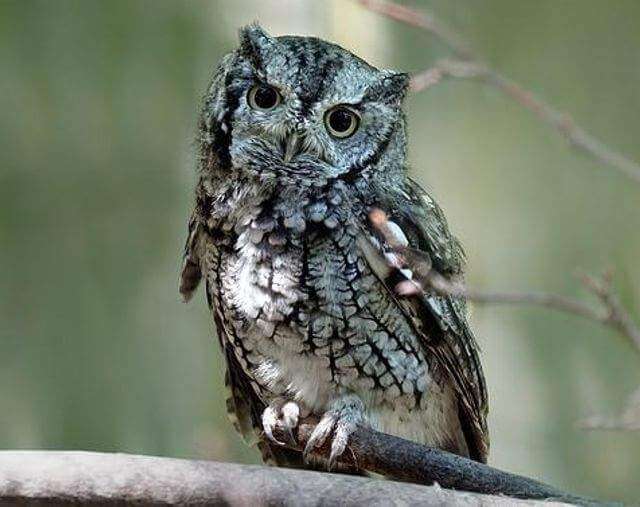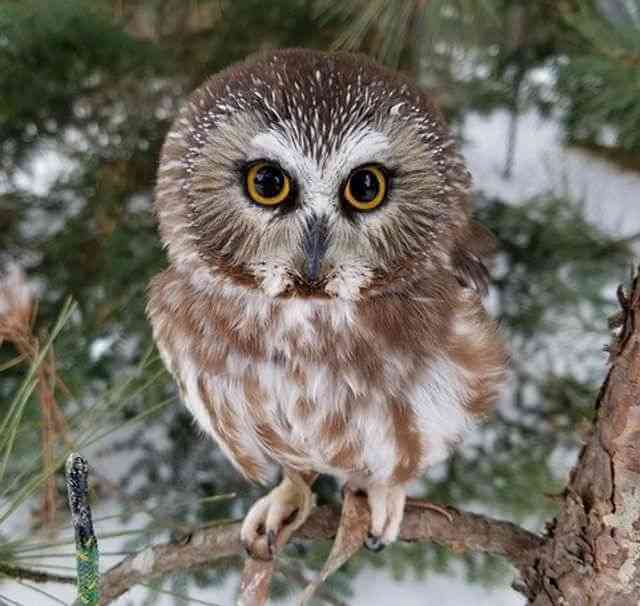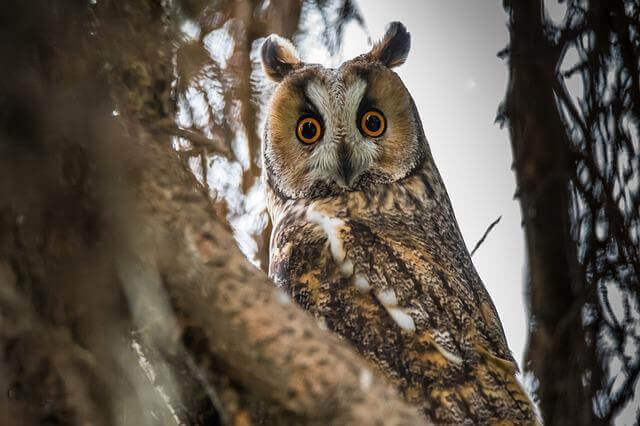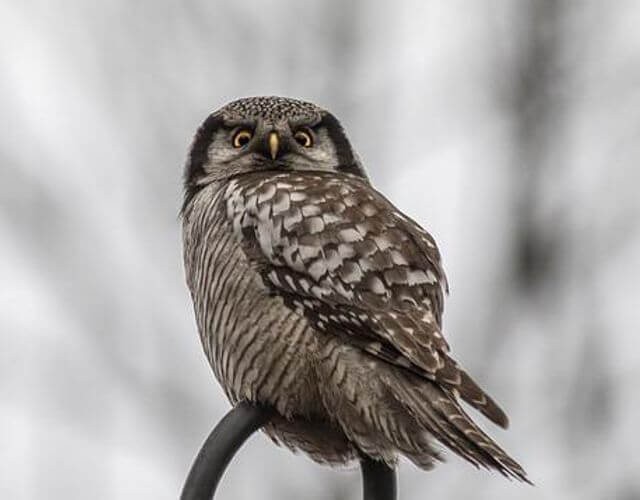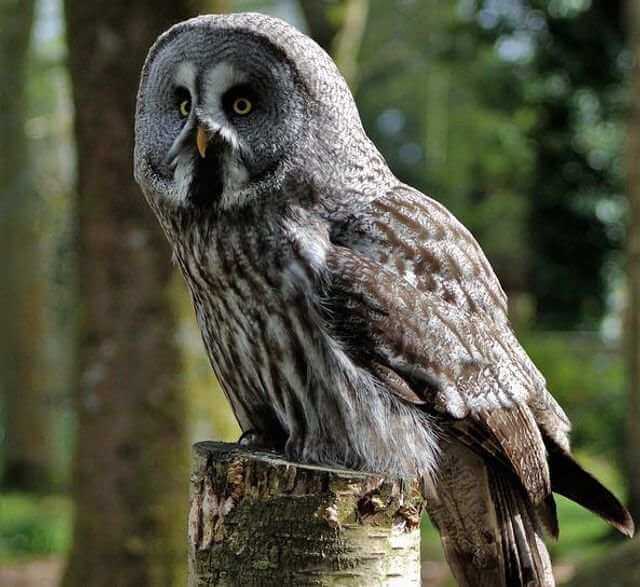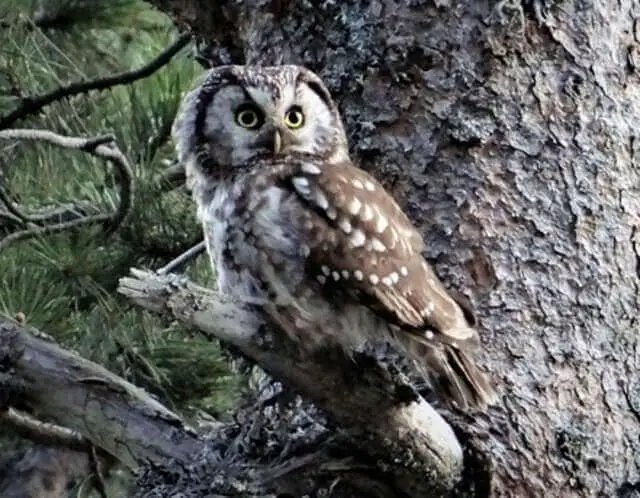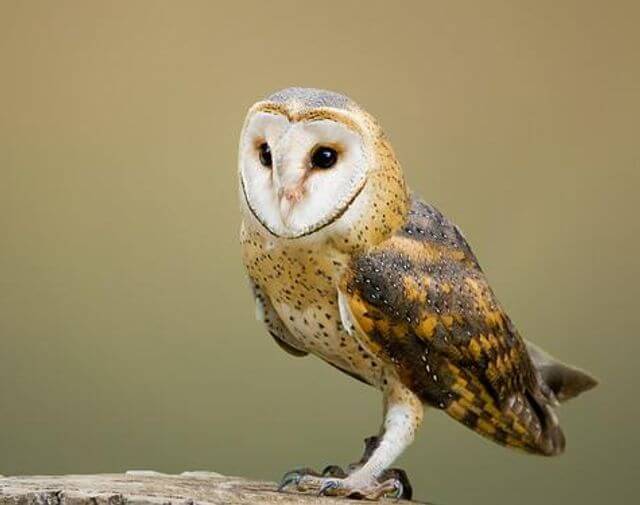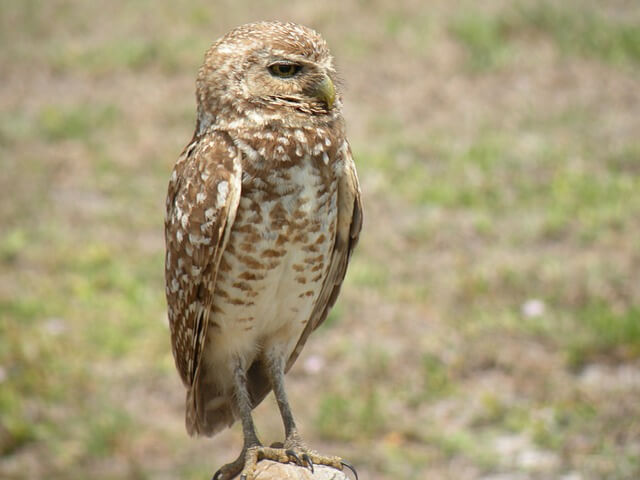Uncover the enchanting world of the 12 types of owls in Michigan! From the elusive Northern Saw-whet Owl to the majestic Snowy Owl, Michigan is home to a diverse array of owl species. Join us as we look into their unique characteristics, habitats, and fascinating facts about these magnificent birds.
Table of Contents
Types of Owls in Michigan
Great Horned Owl
- Length: 17.7-24.8 in (45-63 cm)
- Weight: 32.1-88.2 oz. (910-2500 g)
- Wingspan: 39.8-57.1 in (101-145 cm)
- Scientific Name: Bubo virginianus
- Frequency of Occurrence: 1.02% (Statistic by: eBird)
- Where To Find Them: In Michigan, they are most commonly found in the Upper Peninsula, but they have been seen as far south as Monroe County.
- How to Attract: They are attracted to a variety of things, but their primary attractant is meat. They are also attracted to large open spaces, as well as any type of tree that offers a good hunting platform.
General Information: The Great Horned Owl is one of the most well-known owls in North America. The owl can be found in all 50 states and many Canadian provinces. The owl’s range extends across most of the central and northern North America, from southern Canada to central Texas and eastern New Mexico.
Great Horned Owls prefer woodlands with tall trees and plenty of open space for flying. They also need areas where they can hunt prey silently in the night. In general, Great Horned Owls eat smaller animals, such as mice, rats, squirrels, rabbits and other birds. Nesting great horned owls are very territorial and will defend their nests fiercely against other bird species or humans.
Related Post: 35 Fun Facts About The Great Horned Owl (Detailed)
Barred Owl
- Length: 16.9-19.7″ in (43-50 cm)
- Weight: 16.6-37.0 oz. (470-1050 g)
- Wingspan: 39.0-43.3″ in (99-110 cm)
- Scientific Name: Strix varia
- Frequency of Occurrence: 0.9616%
- Where To Find Them: The barred owl is a large owl found in many locations throughout Michigan. They are most commonly found in the northern half of the state, but have been spotted as far south as Hillsdale County.
- How to Attract: They are attracted to a variety of things, but the main thing that attracts them is the rodent population.
General Information: The barred owl is a large owl found in the Northern and Central United States, as well as parts of Canada. It is a fairly common owl in most of its range, but is less common in the southern portions. The barred owl has a wingspan of around 3.5 feet and can weigh around 2 pounds.
The barred owl is a nocturnal bird and typically hunts small prey such as rodents or birds. Its diet includes mostly small animals, but it will also eat insects, eggs, and carrion. Barred owls are known to build their own nests, often in tall trees or on cliffs. They usually lay two to four eggs per clutch and may incubate them for around 28 days.
Snowy Owl
- Length: 20.5-27.9 in (52-71 cm)
- Weight: 56.4-104.1 oz. (1600-2950 g)
- Wingspan: 49.6-57.1 in (126-145 cm)
- Scientific Name: Bubo scandiacus
- Frequency of Occurrence: 0.7890%
- Where To Find Them: The Snowy Owl is a large owl that can be found in many locations around Michigan. They are most commonly found in the northern part of the state, but have been spotted as far south as Muskegon Heights. The Snowy Owl is usually solitary and hunts for prey at night.
- How to Attract: One way to attract a snow owl is by providing it with a place to hunt. These birds have sharp eyesight and acute hearing, so providing them with fresh meat is essential for their well-being. If you’re lucky enough to live near an open field or forest where the owls can hunt, make sure you keep your backyard free of food sources that would tempt them away from your property. In addition to providing food, another way to attract a snowy owl is by setting up a nest box for them.
General Information: The Snowy Owl (Bubo scandiacus) is one of the largest owls in North America. They can weigh up to 6.5 pounds, making them one of the heaviest owl species. The Snowy Owl ranges throughout most of Canada and the United States, with a few isolated populations in Mexico.
Snowy Owls are found in open habitats, such as taiga and tundra, but are also common in urban areas. They eat mainly small mammals such as rabbits and voles, but will also eat carrion if available. Snowy Owls typically nest in large trees, though they have been known to nest on cliffs and sometimes on artificial structures like power lines.
Related Article: 48 Fun Facts About Snowy Owls (with Photos, ID & Info)
Eastern Screech Owl
- Length: 6.3-9.8″ in (16-25 cm)
- Weight: 4.3-8.6 oz. (121-244 g)
- Wingspan: 18.9-24.0″ in (48-61 cm)
- Scientific Name: Megascops asio
- Frequency of Occurrence: 0.6217%
- Where To Find Them: Eastern Screech Owl are found in various locations across the Lower Great Lakes region of Michigan. They have been documented in the Lower Peninsula, Upper Peninsula, and Mackinac Island. These owls seem to prefer deciduous and mixed forests, as well as areas with plenty of open spaces for hunting.
- How to Attract: Here are some tips on how to attract Eastern Screech Owls. Look for mature trees with a lot of cavities or other places where owls can perch. These owls like to hunt in high up spaces, so locating a tree that is well above ground level will make it more likely that you’ll see one hunting nearby. Spend time outdoors during the day, when Eastern Screech Owls are more active and visible. They love open areas with plenty of trees, fields, and other features nearby. Use food as a tool to attract these owls.
General Information: The Eastern Screech Owl is a widespread owl found in the eastern United States and eastern Canada. This owl is typically found in open areas with plenty of trees, such as forests, fields, and cleared areas. Eastern Screech Owls are carnivorous birds and their diet consists mostly of small prey such as rabbits, squirrels, and mice.
They have also been known to eat birds, eggs, and carrion. Eastern Screech Owls mate in the spring and build a nest from sticks, feathers, and other soft materials. These owls usually lay 2-4 eggs which incubate for around 28 days. The chicks hatch and are able to fly shortly after hatching.
Short-eared Owl
- Length: 13.4-16.9 in (34-43 cm)
- Weight: 7.3-16.8 oz. (206-475 g)
- Wingspan: 33.5-40.5 in (85-103 cm)
- Scientific Name: Asio flammeus
- Frequency of Occurrence: 0.1958%
- Where To Find Them: In Michigan, they can be found in the Upper Peninsula and Mackinac Island.
- How to Attract: To attract the Short-eared Owl to your property, you will need to provide a suitable habitat and make sure that you are providing enough food. They are mainly carnivorous, but will also consume small amounts of insects and other small prey.
General Information: The Short-eared Owl is a medium-sized owl found throughout most of North America. It ranges from southern Canada to central Mexico and throughout most of the Western United States. It resides in a variety of habitats, including woodlands, open areas with scattered trees, and urban areas. The diet consists mainly of small prey, but it also eats some larger animals.
The Short-eared Owl is a common bird in most parts of its range, but it is occasionally persecuted due to its nocturnal habits and perceived harmfulness to agricultural crops. Nesting occurs mainly during the summer months in trees or on cliffs.
Northern Saw-whet Owl
- Length: 7.1-8.3 in (18-21 cm)
- Weight: 2.3-5.3 oz. (65-151 g)
- Wingspan: 16.5-18.9 in (42-48 cm)
- Scientific Name: Aegolius acadicus
- Frequency of Occurrence: 0.1058%
- Where To Find Them: Northern Saw-whet Owls are found in most of Michigan, but they are concentrated in the Upper Peninsula and Mackinac Island. They have also been documented as far north as the Keweenaw Peninsula in the western Upper Peninsula and as far south as Livingston County in the eastern Lower Peninsula.
- How to Attract: Create an owl-friendly garden or yard by planting plants that provide cover and food sources for these birds, such as birch trees, spruces, and junipers. Keep your property clean and free of obstacles that may obstruct the owl’s view or prevent it from landing on perches or tree branches.
General Information: Northern Saw-whet Owl is a small owl found in the boreal forests of Canada and the United States. The owl is also found in Alaska and Russia, but its range is gradually shrinking due to deforestation and climate change. Northern Saw-whet Owl grows to an average size of 18 cm. This owl has a distinctive call that can be heard from great distances.
The diet of the Northern Saw-whet Owl consists primarily of small rodents, such as mice and voles, but it will also eat insects. Northern Saw-whet Owls typically nest in tree cavities, although they have been known to use artificial structures, when available.
Related Article: What is the Smallest Owl in North America?
Long-eared Owl
- Length: 13.8-15.8 in (35-40 cm)
- Weight: 7.8-15.3 oz. (220-435 g)
- Wingspan: 35.4-39.4 in (90-100 cm)
- Scientific Name: Asio otus
- Frequency of Occurrence: 0.1025%
- Where To Find Them: In Michigan, they can be found in the Lower Peninsula, Upper Peninsula, and parts of Southwest Michigan.
- How to Attract: One way to attract the Long-eared Owl is by providing food, such as owl pellets or small animals. Another way is to make your yard look like an owl’s natural habitat. You can try planting trees and shrubs that are common in owl habitats, or mount a nest box in your yard.
General Information: The long-eared owl is a medium to large owl found in the northern hemisphere. The range extends from the Arctic tundra to open taiga and temperate forest, and includes almost all of North America, except for the Southwest. They are typically sedentary, but will migrate if necessary.
Their diet consists mostly of small rodents and birds, but they will also eat insects, amphibians, and carrion. They are solitary creatures during the breeding season, but will form pairs during the winter months when food is more plentiful. Nests are constructed of sticks and mud on high spots or in tree cavities.
Northern Hawk Owl
- Length: 14.2-17.7 in (36-45 cm)
- Weight: 8.5-16.0 oz. (240-454 g)
- Wingspan: 27.9 in (71 cm)
- Scientific Name: Surnia ulula
- Frequency of Occurrence: 0.0351%
- Where To Find Them: They can be found throughout most of the state, but are especially common in the Upper Peninsula and along the northern border.
- How to Attract: To attract a Northern Hawk Owl, you’ll need to provide them with a variety of food sources and a safe place to nest. You can also try to make your home look like an owl’s natural habitat by incorporating trees, and shrubs, into your design.
General Information: Northern Hawk Owls are found throughout most of the United States, except for the south-central and southeastern parts of the country. They inhabit open areas such as grasslands, deserts, and mountainous regions. They are generally diurnal birds that hunt small prey such as rodents, birds, and lizards.
Their diet consists mostly of small animals but they have been known to take down deer and other larger prey on occasion. The northern hawk owl is a solitary bird that nests in cavities such as trees or cliffs. Nests can be located in a variety of environments from arctic tundra to coastal marshes.
Great Gray Owl
- Length: 24.0-33.0 in (61-84 cm)
- Weight: 24.7-60.0 oz. (700-1700 g)
- Wingspan: 53.9-60.2 in (137-153 cm)
- Scientific Name: Strix nebulosa
- Frequency of Occurrence: 0.0092%
- Where To Find Them: They can be found in several locations in Michigan, but are most commonly seen in the Upper Peninsula.
- How to Attract: To attract a great gray owl, you first need to create an environment that is compatible with them. Great gray owls typically live in forests or open areas with plenty of trees and shrubs. You will want to make sure your yard has plenty of these features so that the owl feels comfortable and safe. You may also want to set up some nesting boxes for the owl or build a large platform for them to perch on.
General Information: The Great Gray Owl is one of the largest owls in North America. They can weigh up to 3.5 pounds and have a wingspan of more than five feet. The Great Gray Owl ranges across most of North America, but is especially common in the eastern and central United States.
They prefer open areas with plenty of trees, such as forests, prairies, and wetlands. The Great Gray Owl mainly eats small mammals such as rabbits, squirrels, and chipmunks. Occasionally they will eat larger animals such as carrion or fish. They nest in high-up tree branches usually between May and July.
Related Article: 53 Fun Facts About The Great Gray Owl (Photos, ID & Info)
Boreal Owl
- Length: 8.3-11.0 in (21-28 cm)
- Weight: 3.3-7.6 oz (93-215 g)
- Wingspan: 21.6-24.4 in (55-62 cm)
- Scientific Name: Aegolius funereus
- Frequency of Occurrence: 0.0026%
- Where To Find Them: They are found in Michigan in the Upper Peninsula, Mackinac Island, and parts of the Lower Peninsula.
- How to Attract: To attract these owls, start by creating an inviting environment. Try to keep your yard well-maintained and tidy, and make sure there are plenty of trees and shrubs for them to perch on. If you can, install a nest box for the owl to use. And last but not least, don’t be afraid to get creative – some people have even created owl-themed gardens!
General Information: The Boreal Owl is a large owl found in the boreal forests of North America. This owl has a range that stretches from southern Alaska to Labrador and south to New Brunswick, Quebec and Minnesota. The Boreal Owl inhabits mountainous areas, preferring elevations of 3,000-6,000 feet. They also inhabit moist woods and shrublands near water.
The diet of the Boreal Owl consists mainly of small animals such as voles and lemmings, but they will also eat carrion. They are solitary birds except during the breeding season when pairs form territories. The nests of the Boreal Owl are typically in elevated locations such as trees or ridges. The eggs are incubated for about 28 days by the female owl and the young are fledged after about 50 days.
Barn Owl
- Length: 12.6-15.8″ in (32-40 cm)
- Weight: 14.1-24.7 oz. (400-700 g)
- Wingspan: 39.4-49.2″ in (100-125 cm)
- Scientific Name: Tyto alba
- Frequency of Occurrence: 0.0018%
- Where To Find Them: Barn Owls can be found in a variety of locations and parts of Michigan, but some key places include the Upper Peninsula, the Keweenaw Peninsula, and various parts of the Lower Peninsula.
- How to Attract: There are many things you can do to attract a Barn Owl, including providing a nesting site, food sources, and owl boxes.
General Information: Barn Owls are a common sight in most parts of North America. They are found throughout the eastern and central portions of the continent, as well as in the north-central areas. Barn Owls typically live in wooded areas, but can also be found near open fields or on cliff sides.
They prefer to live in close proximity to other animals, such as mice and bats, which helps them to feed. Barn Owls are carnivores and their diet consists mostly of small rodents and other small animals. They nest in holes in trees or poles and typically have two eggs.
Burrowing Owl
- Length: 7.5-9.8″ in (19-25 cm)
- Weight: 5.3 oz. (150 g)
- Wingspan: 21.6″ in (55 cm)
- Scientific Name: Athene cunicularia
- Frequency of Occurrence: 0.0001%
- Where To Find Them: The Burrowing Owl is usually seen at night, when it comes out to hunt for food. It tends to live in areas with lots of trees and dense undergrowth. It can be found in many different parts of Michigan, including the Upper Peninsula, Lower Peninsula, and parts of the Great Lakes region.
- How to Attract: First, keep your property well-tended. Make sure there is plenty of prey food available nearby, and make sure it is easy to access. You can also create an owl habitat by planting thorns around the perimeter of your property and adding sticks and branches to make a nest. Finally, make sure you keep your noise level down, so the owls don’t become disturbed.
General Information: The Burrowing Owl is a large owl found in central and eastern North America. It ranges from the southern reaches of Manitoba to southern Georgia, and throughout most of the Appalachian Mountains. This owl is generally shy and secretive, but is known to perch for hours on high wires or other exposed perches, watching for prey.
The Burrowing Owl diet primarily consists of insects and small mammals, but it will also eat eggs and fish. Nests are typically constructed in deep burrows, though they have been known to use abandoned fox dens and even hollow trees as nests. For more information on burrowing owls, check out: Really Cool Burrowing Owl Facts That Will Amaze You!
Related Post: Most Common Birds of Michigan (with Photos, ID & Info)

